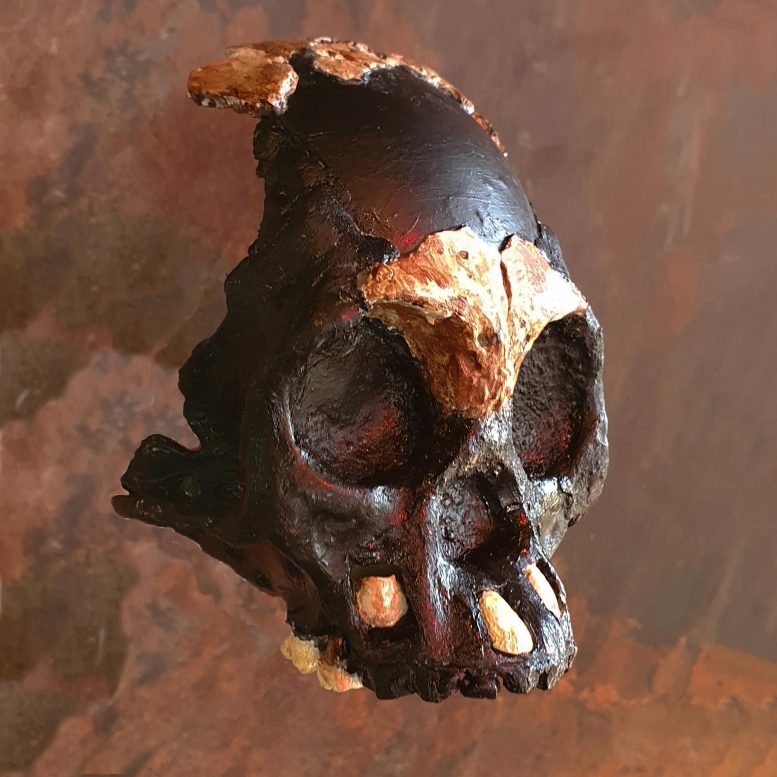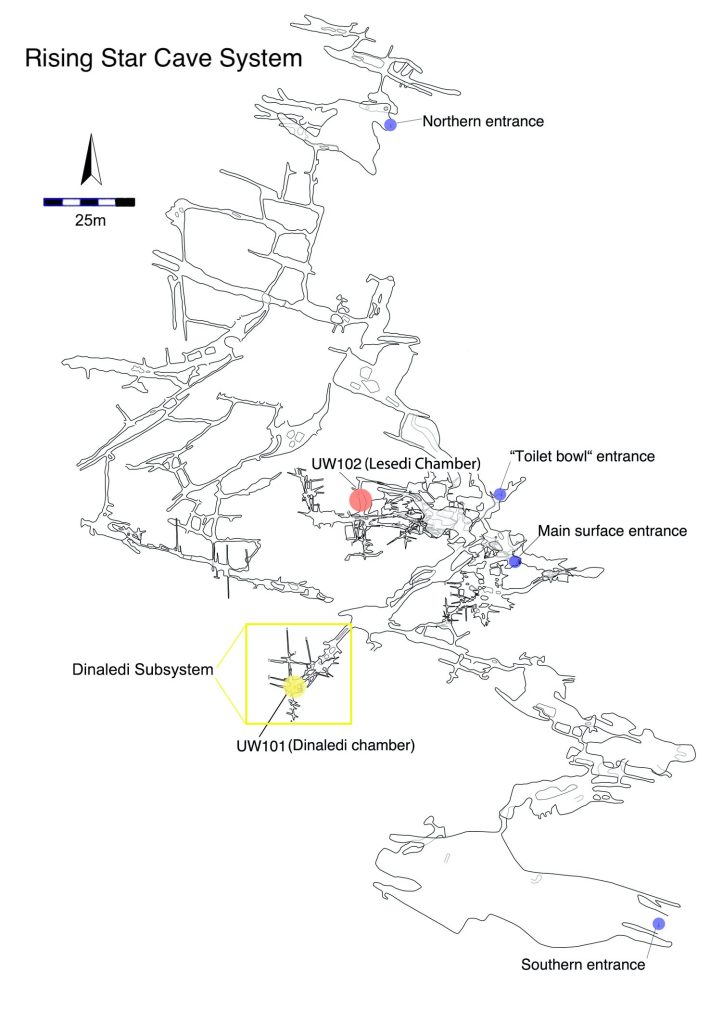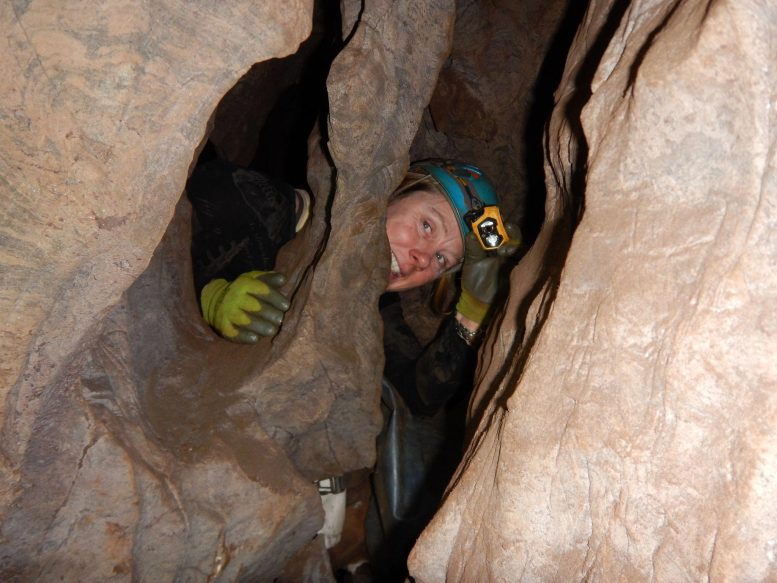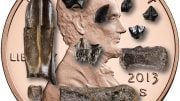
A reconstruction of the skull of Leti, the first Homo naledi child whose remains were found in the Rising Star cave in Johannesburg. Credit: Wits University
The first partial skull of a child of Homo naledi begins to give us insight into all stages of life of this remarkable species.
An international team of researchers, led by Professor Lee Berger from the University of the Witwatersrand, Johannesburg, South Africa (Wits University) has revealed the first partial skull of a Homo naledi child that was found in the remote depths of the Rising Star cave in Johannesburg, South Africa.
Describing the skull and its context in two separate papers in the Open Access journal, PaleoAnthropology, the team of 21 researchers from Wits University and thirteen other universities announced the discovery of parts of the skull and teeth of the child that died almost 250,000 years ago when it was approximately four to six years old.
The first paper, of which Professor Juliet Brophy of Wits and Louisiana State University is the lead author, describes the skull, while the second paper, of which Dr. Marina Elliott is the lead author describe the context of the area and circumstances in which the skull was discovered.
The child was found in an extremely remote passage of the Rising Star Cave System, some 12 meters (40 feet) beyond the Dinaledi Chamber, the original site of discovery of the first Homo naledi remains that were revealed to the world in 2015.
“Homo naledi remains one of the most enigmatic ancient human relatives ever discovered,” says Professor Lee Berger, project leader and Director of the Centre for Exploration of the Deep Human Journey at Wits University and an Explorer at Large for the National Geographic Society. “It is clearly a primitive species, existing at a time when previously we thought only modern humans were in Africa. Its very presence at that time and in this place complexifies our understanding of who did what first concerning the invention of complex stone tool cultures and even ritual practices.”
Almost 2000 individual fragments of more than two dozen individuals at all life stages of Homo naledi have been recovered since the Rising Star cave system was discovered in 2013.
“This makes this the richest site for fossil hominins on the continent of Africa and makes naledi one of the best-known ancient hominin species ever discovered,” says John Hawks, a biological anthropologist and lead author of a previous study on the fossil skeleton of a male naledi nicknamed “Neo” that was also found at the Rising Star cave.
The skull of the child presented in the current study was recovered during further work in the cramped spaces of the cave in 2017. The child’s skull was found alone, and no remains of its body have been recovered. The team have named the child “Leti” (pronounced Let-e) after the Setswana word “letimela” meaning “the lost one.” Leti’s skull consists of 28 skull fragments and six teeth and when reconstructed shows the frontal orbits, and top of the skull with some dentition.
“There were no replicating parts as we pieced the skull back together and many of the fragments refit, indicating they all came from one individual child,” says Darryl de Ruiter, a palaeoanthropologist who previously led a study of the adult skull of H. naledi and who is a co-author on the paper.
“This is the first partial skull of a child of Homo naledi yet recovered and this begins to give us insight into all stages of life of this remarkable species,” says Juliet Brophy, who led the study on Leti’s skull and dentition.
The discovery of a hominin child skull is an extremely rare find in the fossil record as juvenile remains tend to be thin and extremely fragile. “Having skull remains associated with teeth of the same individual is extremely important for understanding the growth and development of this species,” says Christopher Walker, an expert in growth and development.
Leti’s brain size is estimated at around 480 to 610 cubic centimeters (29 to 37 cubic inches). “This would have been around 90% to 95% of its adult brain capacity,” says Debra Bolter, co-author on the paper and a specialist in growth and development. “The size of Leti’s brain makes it very comparable to adult members of the species found so far,” says Bolter.
It has yet to be established how old Leti’s remains are. However, since other fossils of Homo naledi were found in the nearby Dinaledi Chamber and dated to between 335 and 241 thousand years ago, Tebogo Makhubela, part of the geological team investigating the discovery believes that it is likely that Leti is from a similar period, based on preservation and proximity.
Leti’s remains were discovered in a tight passage that measures only 15 centimeters (6 inches) wide and 80 centimeters (32 inches) long and was located just beyond an area named the “Chaos Chamber.”
“The area where Leti was found is part of a spiderweb of cramped passages,” says Maropeng Ramalepa, a member of the exploration team responsible for bringing the remains to the surface. Marina Elliott, one of the original “Underground Astronauts” in the first Rising Star expedition that originally uncovered Homo naledi and the leader of the excavation team that recovered Leti described the challenge of excavating Leti as “very difficult.” “This was one of the more challenging sites with hominin fossils we have had to get to in the Rising Star system,” says Elliott.
Since its discovery, the Rising Star cave system has become one of the most prolific sites of discovery for hominin fossils in the world. Berger says that work is continuing throughout the cave system and that soon new discoveries are likely to shed further light on whether these chambers and passages are in fact a burial ground of Homo naledi, as the team originally hypothesized.
“I do not believe there is another site quite like Rising Star,” says Steve Churchill, a palaeoanthropologist and co-author on both papers. “This is now the third locality we have described from this system with naledi remains, and we know through exploration that there are other localities.”
With no signs of carnivore damage or damage made by scavenging, and no evidence of the skull having been washed into the narrow passage, the team does not know how Leti’s skull came to rest, alone, in such a remote and inaccessible part of the system. The authors hypothesize that it is likely other members of its species were involved in the skull reaching such a difficult place.
“The discovery of a single skull of a child, in such a remote location within the cave system adds mystery as to how these many remains came to be in these remote, dark spaces of the Rising Star Cave system,” says Berger. “It is just another riddle among many that surround this fascinating extinct human relative.”











Greetings…
Will the public ever see the “original” structure of this “A Child of Darkness” Skull?
Apparently it states it’s a Reconstruction? humour at its finest.
Nanu:
I believe “reconstruction” means the (human, in this case) remains were found in pieces, which were carefully reassembled into their original structure.
This is pretty typical of human remains that are thousands of years old, as well as even older dinosaurs, ancient pottery, etc.